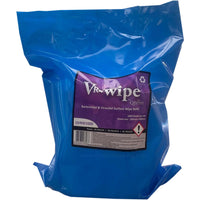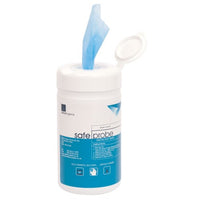Collection: Cleaning and Disinfectant Wipes
Convenient cleaning and disinfectant wipes offering quick alternatives to spray-and-cloth cleaning methods. Bactericidal, virucidal and sanitising surface wipes in various pack sizes including tubs and refill rolls. Essential for healthcare, catering, office and commercial environments requiring immediate cleaning and disinfection capabilities with professional-grade effectiveness.

Wipes Product information
Cleaning wipes represent convenient, immediate-use solutions that combine cleaning agents with ready-to-use application systems, providing efficient
sanitisation and surface cleaning across diverse commercial, healthcare, and catering environments where speed and convenience are essential.
At ClickCleaning, we provide a comprehensive range of professional cleaning and disinfectant wipes designed to meet stringent hygiene requirements whilst offering the convenience and portability essential for modern cleaning operations. Our selection includes bactericidal and virucidal surface wipes, sanitising solutions, and specialised formulations such as 70% IPA wipes for critical applications.
The fundamental advantage of professional wipes lies in their immediate availability and consistent application, eliminating the preparation time associated with traditional spray-and-cloth methods whilst ensuring appropriate solution concentration and contact time for effective cleaning and disinfection. This convenience proves particularly valuable in fast-paced environments where efficiency and hygiene must be maintained simultaneously.
Bactericidal and virucidal wipes like V-Wipe provide comprehensive antimicrobial activity against bacteria and viruses, essential for healthcare
environments, food service operations, and public facilities where pathogen control is critical. These formulations undergo rigorous testing to ensure
efficacy against specific organisms whilst maintaining surface compatibility across diverse materials.
Sanitising wipes such as Sanisafe offer balanced cleaning and disinfection for general commercial applications where routine hygiene maintenance is required without the intensive antimicrobial activity needed for clinical environments. These products provide cost-effective solutions for offices, retail environments, and general commercial facilities.
Specialised formulations including 70% IPA (Isopropyl Alcohol) wipes deliver rapid antimicrobial activity with quick evaporation characteristics essential
for electronics, medical devices, and applications requiring residue-free cleaning. These products meet stringent requirements for critical cleaning
applications whilst providing convenient application methods.
Packaging options accommodate diverse operational requirements from individual tub containers suitable for point-of-use applications to bulk refill
systems like the Quattro VR-Wipe refill rolls that support high-volume operations whilst reducing packaging waste and operational costs.
Convenience factors include pre-measured solution concentrations that ensure consistent antimicrobial activity without dilution errors, portable packaging that enables cleaning at point-of-need, and ready-to-use application that eliminates preparation time essential for maintaining cleaning protocols during busy operational periods.
Surface compatibility ensures that professional wipes work safely across diverse materials including plastics, metals, glass, and composite surfaces
commonly found in commercial environments. Quality formulations balance antimicrobial efficacy with material safety to prevent damage whilst delivering thorough cleaning and disinfection.
Regulatory compliance considerations include selecting wipes that meet specific industry standards for healthcare, food service, or commercial applications. Products undergo testing and certification processes that ensure appropriate efficacy claims and safety profiles for intended applications.
Contact time requirements vary by product and target organisms, with most professional wipes designed for practical contact times that balance antimicrobial efficacy with operational convenience. Understanding appropriate contact times ensures effective pathogen control whilst maintaining realistic application procedures.
Environmental considerations include selecting wipes with biodegradable materials and responsible disposal practices that minimise environmental impact whilst maintaining the convenience and efficacy benefits essential for professional cleaning operations.
Cost-effectiveness emerges through reduced labour requirements, eliminated preparation time, consistent application concentrations, and the prevention of cross-contamination incidents that could create significant remediation costs. The convenience often justifies premium pricing through operational efficiency gains.
Quality assurance ensures consistent moisture content, antimicrobial activity, and material integrity throughout product shelf life, providing reliable performance essential for professional cleaning operations where consistency directly impacts hygiene outcomes and operational efficiency.
Whether you're maintaining healthcare facilities requiring stringent infection control, operating food service environments with critical hygiene standards, managing office environments with routine sanitisation needs, or addressing any application requiring convenient, effective cleaning and disinfection capabilities, ClickCleaning offers professional wipe solutions that combine proven antimicrobial efficacy with operational convenience.
Please contact us if you have any questions about our range we can assist with.
Wipes FAQs
What's the difference between bactericidal, virucidal, and sanitising wipes?
Bactericidal wipes are formulated specifically to kill bacteria, virucidal wipes target viruses, whilst products like V-Wipe combine both capabilities for comprehensive pathogen control. Sanitising wipes like Sanisafe reduce microbial contamination to safe levels but may not eliminate all pathogens like dedicated bactericidal/virucidal products. The choice depends on your specific hygiene requirements—healthcare and food service typically need bactericidal/virucidal efficacy, whilst general commercial environments may find sanitising wipes adequate. Always verify efficacy claims and regulatory compliance for your specific application. Combined bactericidal/virucidal wipes provide comprehensive protection but may cost more than sanitising alternatives for routine cleaning applications.
Are cleaning wipes more effective than traditional spray-and-cloth methods?
Wipes offer several advantages including pre-measured solution concentrations ensuring consistent antimicrobial activity, immediate availability eliminating preparation time, and reduced cross-contamination risks from reused cloths. They provide reliable contact time and prevent dilution errors common with spray applications. However, traditional methods
may be more cost-effective for large surface areas and offer more control over solution quantity. Wipes excel for point-of-use cleaning, high-touch surfaces, and situations requiring immediate sanitation. Traditional methods suit extensive cleaning operations and budget-conscious applications. Many facilities use both strategically—wipes for convenience and critical applications, sprays for routine large-area cleaning. The effectiveness depends more on proper technique and contact time than application method.
What surfaces can I safely clean with disinfectant wipes?
Most professional wipes work safely on hard, non-porous surfaces including plastics, metals, glass, sealed wood, and composite materials common in commercial environments. They're ideal for high-touch surfaces like door handles, keyboards, phones, and equipment. However, avoid use on porous materials, unsealed wood, or surfaces that might absorb moisture. Some formulations may affect certain plastics or finishes—always test in inconspicuous areas first. Electronics require special consideration—products like 70% IPA wipes evaporate quickly and suit electronic devices better than heavily moistened alternatives. Natural stone, marble, or specialty surfaces may need specific products. Check manufacturer compatibility guidelines and surface warranties before use.
How long should I leave disinfectant wipes on surfaces for effective kill times?
Contact time varies by product and target organisms, typically ranging from 30 seconds to 10 minutes for complete antimicrobial activity. Most professional wipes like V-Wipe specify contact times on product labels—follow these guidelines for effective pathogen control. Surfaces should remain visibly wet during contact time for optimal efficacy. For routine cleaning, 1-2 minutes contact time provides good general disinfection. Critical applications may require longer contact times. Don't wipe surfaces dry immediately—allow appropriate contact time for antimicrobial activity. If surfaces dry before specified contact time, apply additional product. Understanding and following contact time requirements ensures effective pathogen control whilst maintaining practical application procedures.
Are wipes suitable for food service and healthcare environments?
Quality disinfectant wipes are specifically designed for food service and healthcare applications where stringent hygiene standards are essential. Products like V-Wipe and Sanisafe undergo testing for efficacy against relevant pathogens. However, verify regulatory compliance and approval for your specific application. Food service may require food-safe formulations or rinsing procedures. Healthcare environments need products tested against healthcare-associated pathogens. Consider contact times appropriate for operational workflows. Some facilities may require specific certifications or approval processes. Always check local health department requirements and facility policies before implementing wipe programmes. The convenience and consistent application make wipes valuable for these critical environments when properly selected and used according to protocols.
Can I use the same wipes for different areas and surfaces?
Avoid using the same wipe across different areas to prevent cross-contamination between surfaces. Use separate wipes for different zones—don't use bathroom wipes in kitchen areas or patient care wipes for general cleaning. Even within the same area, use fresh wipes for different surfaces when contamination transfer is a concern. The "one wipe, one surface, one direction" principle minimises contamination spread. For general commercial cleaning, single wipes can clean similar surfaces in the same area, but replace frequently. Healthcare and food service require more stringent protocols with dedicated wipes for specific areas or tasks. Plan wipe usage to prevent contamination transfer whilst optimising efficiency and product usage.
What's the shelf life of cleaning wipes and how should I store them?
Professional wipes typically have 2-3 year shelf life when stored properly, though check specific product dates. Store in cool, dry conditions away from direct sunlight and temperature extremes that might affect moisture content or chemical stability. Keep containers tightly sealed to prevent drying out—dried wipes lose effectiveness and convenience benefits. Avoid storage near heat sources or in areas with temperature fluctuations. Once opened, use within recommended timeframes to maintain moisture and antimicrobial activity. Monitor containers for drying or separation that might indicate storage issues. First-in, first-out rotation ensures fresh stock usage. Proper storage maintains product effectiveness whilst maximising shelf life and operational reliability.
Are there environmental considerations with disposable wipes?
Disposable wipes create waste that requires proper disposal, unlike reusable cloth systems. However, they often reduce overall chemical usage through pre-measured concentrations and prevent contamination from reused cloths. Look for wipes made from biodegradable materials where available. Consider usage patterns—wipes may be more sustainable for point-of-use applications whilst traditional methods suit large-area cleaning. Some facilities implement hybrid approaches using wipes for critical applications and traditional methods for routine cleaning. Proper disposal prevents environmental contamination whilst maintaining hygiene benefits. The convenience and infection control benefits
often justify environmental costs in healthcare and food service applications. Balance environmental considerations with hygiene requirements and operational efficiency for optimal sustainability.
Can I flush cleaning wipes down toilets or drains?
Never flush cleaning wipes, even those labelled "flushable," as they can cause serious plumbing blockages and environmental issues. Most cleaning wipes contain synthetic materials that don't break down in sewage systems. Dispose of used wipes in regular waste bins following local waste management guidelines. Some formulations may require special disposal procedures—check product labels and safety data sheets. The chemicals in disinfectant wipes can also disrupt sewage treatment processes. Proper disposal prevents costly plumbing repairs and environmental contamination. Train staff on appropriate disposal procedures to prevent accidents and system damage. The convenience of wipes comes with responsibility for proper waste management.
What's the most cost-effective way to use cleaning wipes incommercial operations?
Cost-effectiveness comes from strategic usage rather than wholesale replacement of traditional cleaning methods. Use wipes for high-touch surfaces, point-of-use cleaning, and critical hygiene applications where convenience and consistent application justify premium costs. Traditional methods remain more economical for large surface areas and routine cleaning. Consider bulk refill systems like Quattro VR-Wipe rolls for high-volume operations to reduce per-unit costs. Train staff on proper usage to prevent waste—one wipe per surface/task prevents overuse. Monitor usage patterns to identify optimal applications and potential waste. Calculate total costs including labour savings from convenience against product costs. Most facilities achieve best value through strategic wipe deployment combined with traditional cleaning methods for appropriate applications.
















